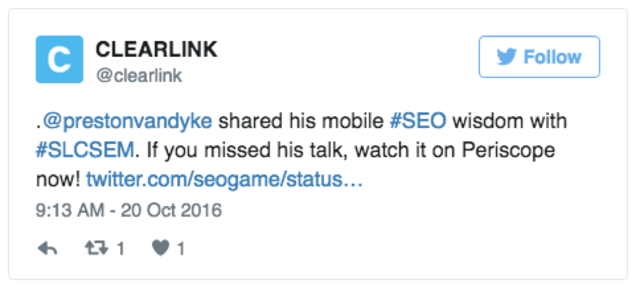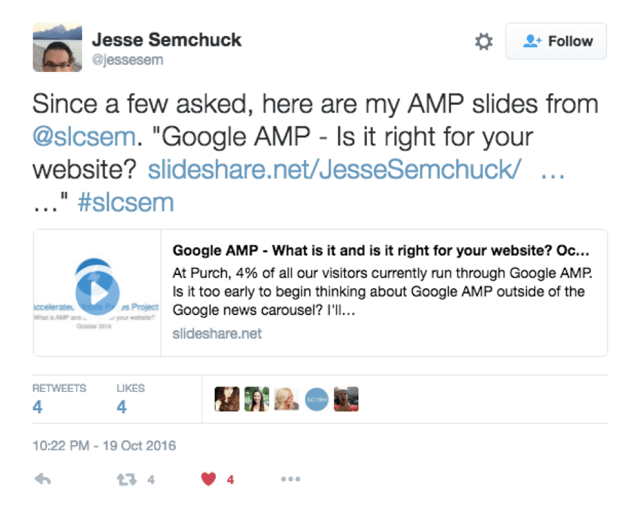
Mobile search has continued to increase with the new era of smart phones. As such the need for mobile SEO optimization is imperative to keep your business relevant and visible with the ever-changing online marketing industry. In addition, have you ever wanted to learn more about Google’s AMP? Last week at SLC|SEM, we had the opportunity to see 2 great speakers. Preston Van Dyke educates attendees on how to keep your SEO strategy up to date and in line with these mobile search trends. Jesse Semchuck follows with what to know about Google’s AMP.
Preston Van Dyke – Mobile SEO
Preston was the first speaker at the conference, and the knowledge that he shared regarding the future of search with regard to mobile SEO was spot on! During his presentation, we learned that as of last year, more than half of all search occurred on a mobile device. This trend is certain to continue increasing year over year with more users engaging in mobile searches on their smart phones. In 2015, Google announced that mobile would be considered a ranking factor in SEO considerations. We then learned that Google would be splitting the ranking index between desktop and mobile into these considerations. Previously, 80% of this index was algorithm and the other was 20% mobile. Mobile was previously found to be following suit of desktop device trends, it is likely that this will flip flop and mobile ranking with be the leading factor for SEO rankings.
How can we be "Mobile First" in the year 2017?
As we see this paradigm shift in search engine optimization, it is important to keep your strategies in line with these changes. Your websites mobile compatibility and user experience will be a strong indicator of your websites overall SEO rankings and online presence. There will likely be an emphasis on site speed, primarily on mobile.
What are the metrics that impact site speed?
- Time to First Bite (TTFB)
- Document Load Times
- Page Speed Score
To be mobile first, we need to view these metrics in the mobile experience versus the desktop version. You can do this by improving your site speed. Keep in mind that you can improve your mobile site speed without improving your page speed score. As an advertisor, you can then focus on content planning. When creating content, focus on optimizing your mobile site for SEO. This means that when minimizing content to fit the mobile experience, its crucial to add all relevant SEO considerations. Your call to action needs to be above the fold and its important to have all onsite optimizations in place such as your H1’s, Metas, Title Tags to help your organic mobile rankings.
Later in Preston’s presentation, he then sparks the idea, ‘If we need to be Mobile First in 2017, will our next search venture be Voice First in 2018?’. Maybe, as voice search is continuing to increase year over year. This means that the content that we create needs to be device agnostic to stay ahead of the curve.

Our next speaker was Jesse Semchuck who discusses the future of Google’s AMP. To first learn more about this, let’s first look at Google’s definition of AMP:
“AMP HTML is HTML with some restrictions for reliable performance and some extensions for building rich content beyond basic HTML. The AMP JS library ensures the fast rendering of AMP HTML pages. The Google AMP Cache can be used to serve cached AMP HTML pages.”
Jesse Semchuck – Google AMP
Google’s definition of AMP explains that it is an open source that is an industry collaborative approach to increase views and maintain advertising control. It is an open source to contribute too and is dedicated to keeping the web fast. It produces fast content that you give to Google to cache and load to scale for you.
Jesse explains in his presentation that on average, adults spend an average of 3 hours per day on smart phones. Human attention spans are also consistently getting shorter. The average mobile page load time is 19 seconds. AMP pages load in under 1 second. With that said, 40% of users will bounce from a page if it does not load after 3 seconds. With the raise of mobile speeds, it is important to incorporate AMP into your advertising as applicable to keep your content relevant and appearing.
Mobile vs. AMP
As an advertiser, you should consider the differences between mobile and AMP. AMP is cleaner, loads much faster, however content needs to be very strategically placed on what you want the reader to see. AMP SERPs are preloaded which can drive significant revenues for publishers. In addition, it is important to note that currently ads on AMP are very limited.
With regard to launching AMP pages, Jesse explains it is a wise strategy to test many configurations of your content. Plan on modifying your AMP page 2-3 times to get your desired user experience.
Should I use AMP?
When considering using AMP, ask yourself if it will increase your revenue? Jesse walks us through many common scenarios to help to know your audience. Do you have a younger tech-savy audience, news content, resources consistently up to date? Then you may want to utilize AMP. Is your target demographic older, or you have a lead gen company that is small to mid-sized? Maybe in 2017.
Remember to always keep your demographic in mind and remember that some properties may also be better served by making your mobile site faster.

